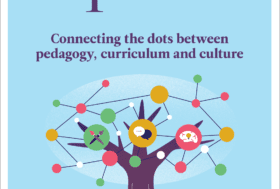This video shows practitioners supporting young children’s learning at Sheringham Nursery School and Children’s Centre in east London, a maintained nursery school for children aged two, three and four. The setting works closely with parents and carers and is fully inclusive, with a number of places prioritised for children who have special educational needs and disabilities.
As you watch the video, consider how the practitioner supports high-quality interactions to support children’s learning. Specifically, notice how the practitioner provides practical support while allowing the children to carry out the task as independently as possible. What do you notice about the conversation between the practitioner and the children?
You need to be logged in to view this video
It’s OK. It doesn’t matter if it gets on the table. We’ll clean it up afterwards. But [child’s name] is going to measure a full cup of flour…
[children speaking]
… it has to go right to the top.
Oh my!
Whoa, that was a big spoonful.
[child speaking]
That’s OK.
[children speaking]
It’s a bit tricky, isn’t it? To pour in…
[children speaking]
I’ve a bigger one.
An even bigger one. Yeah, so that’s called a tablespoon. And if you look here, that’s for measuring the oil.
[child speaking]
Right, [child’s name]… Nearly, let’s see, do we think it’s full?
Yes.
Perfect. So pour it in to your bowl. Now, if we look carefully at the recipe, we need 2 cups of flour.
[children speaking]
Oh, you dropped it. That’s OK. I wonder, let’s see if we can do it, so you can reach the flour at the same time. We need a better container, don’t we?
[children speaking]
Yeah, [child’s name], do you want to scrape it up a bit?
Shall I use this one?
Yeah, that’s a good idea. I’m just going to open this so you can reach the flour. Maybe, you can try and fill your cup as well because we need 2 cups. So if you do yours…
Then I have to stand up…
You can stand up, it will make it easier. Yeah, why don’t you move this closer to you? There you go. And pour it into your cup first, [child’s name]. There you go. Oh, floury hands.
We’re going to put it here. Yes, this is salt.
[children speaking] That’s OK. We can clean it afterwards.
[children speaking]
Yes. Yeah, but we’re going to follow the recipe. So we need 1 cup of salt… maybe, let’s see. If you pour it very gently and carefully into here, we can make 1 cup.
Yeah.
Yeah. And then when you’ve done that, [child’s name], you can add that to the bowl.
I’m not done yet.
No, I know. You’ve still got a bit more space, haven’t you? Yeah, so watch the salt. [child’s name] is pouring it really carefully to measure it out. We need 1 cup.
A little too many.
It is a brand new container of salt. [child’s name] is really concentrating.
There are too many.
You think there’s too much?
Yeah, so many inside it.
So much salt inside. You can see it pouring out.
It’s already so sugary.
Too many.
It does look a bit like sugar, doesn’t it? This is called salt.
[children speaking]
It does look like sugar. Sugar and salt, white sugar and salt looks the same. Let’s have a look.
Do you think I’m done?
I think there’s a little bit more space. Do you think you could fit some more in?
Yeah, have another try. Just make sure it reaches the very top of the cup.
[children speaking]
Whoa! So look. We’ve got to measure out the next ingredient. Can you remember what it is? Have a look at the recipe. We’ve had 2 cups of flour, 1 cup of salt…
Oh, yeah.
Oh, yeah, 2 tablespoons…
We need both of them.
So we need this smaller…
Smaller one.
Yeah, for the oil. And look, it’s over here.
[children speaking]
So we’ve got all of our ingredients.
[child speaking]
Perfect. Now, you can put it in your bowl.
[child speaking]
Yeah.
[child speaking]
Yes, look. Can you see the recipe? You can have two. Well done. Now, this bottle is quite big and heavy.
Heavy.
So let’s think about… I think that the oil is going to come out of it really, really quickly.
Oh my goodness!
Oh my goodness!
[children speaking]
OK, so why don’t you hold that over the bowl… hold your cup. Do you want to try pouring it?
[children speaking]
Go on then. So what we need to do… Do you want me to hold this? All right, have a try. It’s a bit tricky because it’s quite heavy. Do you think you can do it?
[child speaking]
Woah! Right. I’ll hold that over there. Can you turn it? Hmm. It’s a bit tricky. We need a smaller container.
A bigger container.
Twist it around a bit.
[children speaking]
Well done, [child’s name]. Lift it up, right. Let’s do it slowly. Go on.
Slowly, slowly, slowly.
It’s coming.
And we need… Perfect. Pour it in.
[child speaking]
That’s OK. It was just to catch the little drips, wasn’t it? And then another one.
Yeah.
Yeah, two. Hi [child’s name]. You got it.
Is this salt?
It is. Wow, that was excellent pouring and measuring.
Well done.
Well done. You’re done. Just one moment, I’m just going to put the oil here. So look. Let’s have a check what [child’s name] needs next. She’s put 2 cups of flour, 1 cup of…
Salt.
…salt. And… hmm, can you remember what this was called?
A measurement.
It is a measurement. It’s called a tablespoon.
And now this one.
Yeah. And now you need to use the same tool to measure the cream of tartar. So [child’s name], would you like to… you can do some salt in just a moment. I’m just going to open this.
It’s a bit tricky because it’s new.
I can do it myself.
[child speaking]
Yeah. There are, aren’t there?
There we go…






